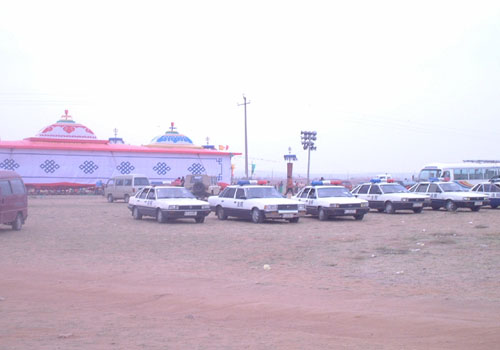| Reuters |
| Jan 17, 2007 |
| By Ben Blanchard |
 |
|
| Mongolian traditional
summer gathering "Naadam" festivals are always under the
authorities' tightened surveillance. Photo is a scene of
Naadam in western Southern Mongolia's Bayannuur League ---
SMHRIC |
|
HOHHOT,
China (Reuters) - Annie Feng seems like an easy-going person,
with her ready smile and happy demeanor.
But ask
the young teacher who she wants to marry and her expression
turns serious.
"A
Mongolian of course," said the 24-year-old. "They are my people.
I could never marry a Han Chinese. My parents would never let it
happen anyway."
Feng, a
Chinese citizen, is also an ethnic Mongolian, a people who eight
centuries ago were united by Genghis Khan and forged an empire
that stretched from Beijing to Poland.
Today,
decades of migration by the dominant Han has made Chinese
Mongolians a minority in their own land, officially comprising
less than 20 percent of the almost 24 million population of the
Inner Mongolian Autonomous Region.
Still,
more Mongolians live in China than Mongolia.
Inner
Mongolia, which covers more than a tenth of China's land mass,
is supposed to offer a high degree of self-rule. In practice,
though, Mongolians say the Han run the show.
"There are
very few Mongolians with any real power here," said Dulaan, who
runs a Mongolian art and book shop in Hohhot, capital of the
autonomous region.
"Mongolians are always deputy managers rather than manager.
Those places are reserved for the Han," she added.
In
November, police raided Dulaan's shop and several others in
Hohhot and seized Mongolian language books and CDs, under the
pretext, she says, of cracking down on piracy and illegally
imported foreign publications.
But she
says the real reason was political.
"The Han
fear anything that suggests national pride in being Mongolian,"
Dulaan said, gesturing to a calendar written in the cursive,
classical Mongolian script, which looks a little like Arabic
written on its side and read from top to bottom.
"They
think our beliefs have some political motivation," she added.
"They are even scared when 50 or 100 of us gather for a wedding.
They think we're plotting something."
LITTLE
KNOWN
Mongolian
activists complain that the plight of their people is little
known in the outside world, unlike that of the Tibetans or the
Muslim Uighurs in China's far west.
"There's
much less focus on us," said Xinna, wife of an ethnic Mongolian
academic serving a 15-year jail term for separatism and
considered by Amnesty International to be a prisoner of
conscience.
She denies
that either she or her husband, Hada, want independence for
Inner Mongolia, or even union with Mongolia. For her, it is
about garnering greater respect and making sure Mongolian
culture is protected and nurtured.
"Lots of
Mongolian children are growing up not speaking their own
language," Xinna told Reuters. "Parents think that being
educated in Chinese gives their children a better chance of
getting a job."
That's a
problem that Erdun, who graduated from university last summer,
has faced.
"It's
harder to find a good job if you have been educated in
Mongolian," said Erdun, 21, from the eastern city of Chifeng,
who works as a hotel bellhop.
"As soon
as you go for an interview they know Chinese is not your native
tongue and that makes people more reluctant to hire you," he
said in lightly accented Mandarin.
By law,
Mongolian script -- replaced by a cyrillic alphabet in Mongolia
-- is meant to be used on shop, street and government signs, and
there is a Mongolian language television channel which plays
lots of dubbed, politically vetted Chinese dramas.
Yet few
Han speak Mongolian, and the two groups are often separately
schooled.
WRONG
SIGNS
Beijing,
sensitive about ethnic unrest in strategic border areas like
Inner Mongolia and Tibet, keeps a tight rein on minorities.
It has
closed Web sites accused of promoting Mongolian nationalist
ideas, banned concerts by groups from Mongolia proper and
cracked down on student reading groups, according to rights
groups and activists.
"The
government thinks that any type of gathering by Mongols will
possibly cause some danger to their regime," said Enghebatu
Togochog, president of the New York-based Southern Mongolian
Human Rights Information Center.
"They are
really nervous about that kind of gathering."
On the
surface, the government gives the Mongolians a lot of leeway,
allowing them to use their native language at all levels of
officialdom, but Togochog said that appearances are deceptive.
"Mongolian
people have long names, but Chinese passports are limited to
only three or four letters. Thus we cannot use our family
names," he said.
"If you
really check carefully, most of the Mongolian signs are wrong.
They are written by Chinese people who don't know and don't care
about it," Togochog said by telephone. "Sometimes they hang the
signs upside down." |





